Opportunities of AI in Special Education
Explore how AI in special education personalizes learning, supports diverse needs, and raises important questions about privacy and balance.
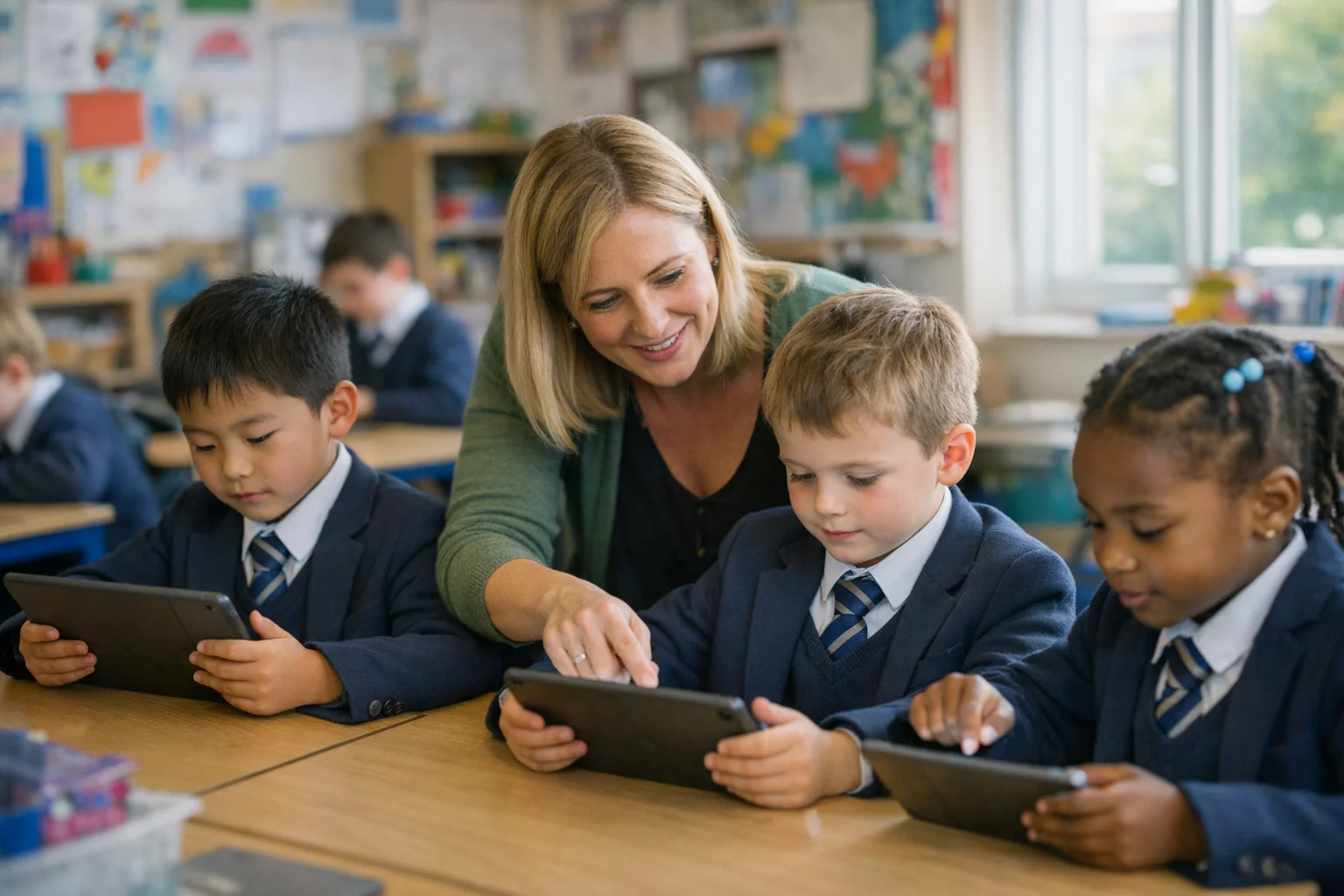

Envision a classroom where AI meticulously customizes lessons for each student, fostering growth at an individualized pace. The prospect of computers collaborating with educators to enhance the educational landscape is both thrilling and thought-provoking.
AI's role in special education transcends being a mere futuristic notion; it is a burgeoning reality, actively crafting personalized learning pathways and enhancing education accessibility for students with special needs. This technology adeptly accommodates varied learning styles and empowers non-verbal or multilingual students to express themselves. While it equips educators with valuable data and innovative tools, it concurrently raises concerns regarding privacy and the vital equilibrium between technology and critical-thinking skills.
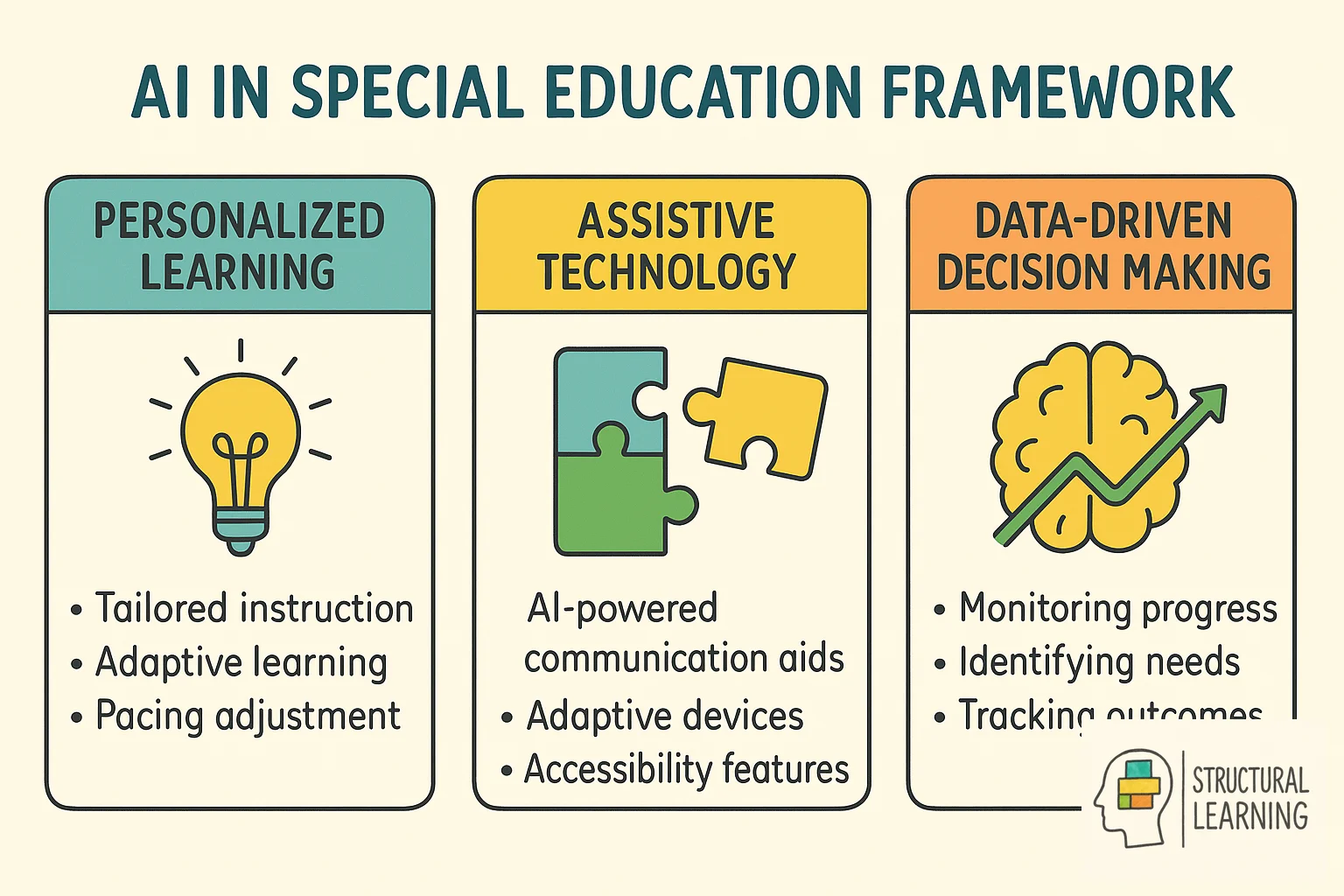
This article will meticulously examine the multifaceted aspects of AI in special education, emphasizing the opportunities it presents and the challenges it may introduce. We will explore how AI can support educators, address challenges such as teacher shortages, and underscore the necessity of aligning AI tools with educational objectives. Let us navigate this evolving era of learning and explore the path where the synergy between humans and technology may lead.
AI in special education offers personalized learning pathways that adapt to each student's unique needs and learning pace. The technology enhances accessibility through tools like text-to-speech and adaptive communication systems, while streamlining administrative tasks for educators. These benefits help ensure students with special needs receive more individualized attention and support.
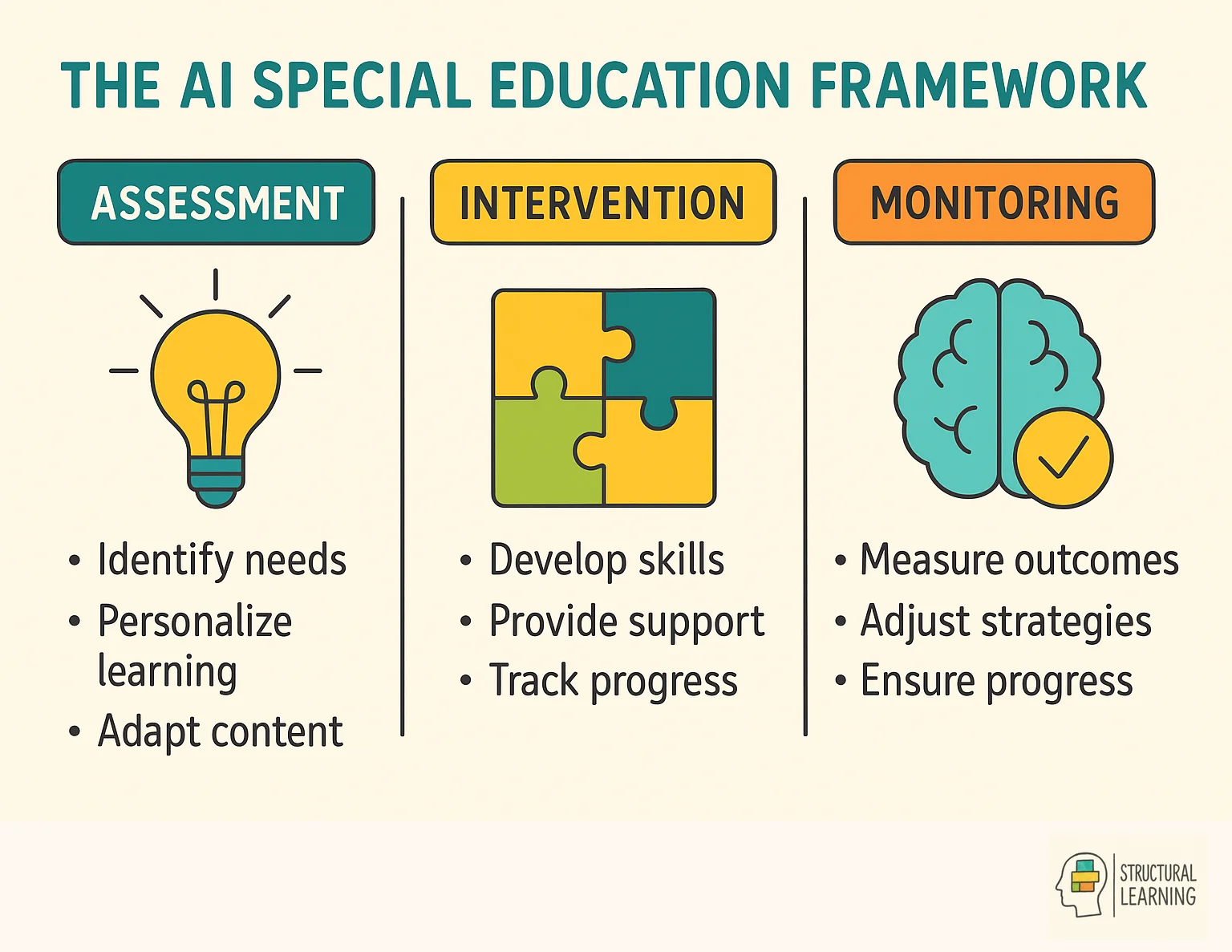
Exploring the promise of AI in special education feels, well, a bit like we're stepping into the future today. AI tools offer exciting opportunities to enkindle highly engaging, individualized activities for students with special needs.

Benefits of AI in Special Education:
Despite its potential, several concerns persist, namely data privacy, cost implications, and the risk of diminishing essential human interaction in educational settings. While AI has the potential to revolutionize special education, balancing these tools with human touch remains crucial. As teachers and AI join forces, perhaps the challenge is to dance gracefully between technology and human connection, ensuring neither overshadows the other.
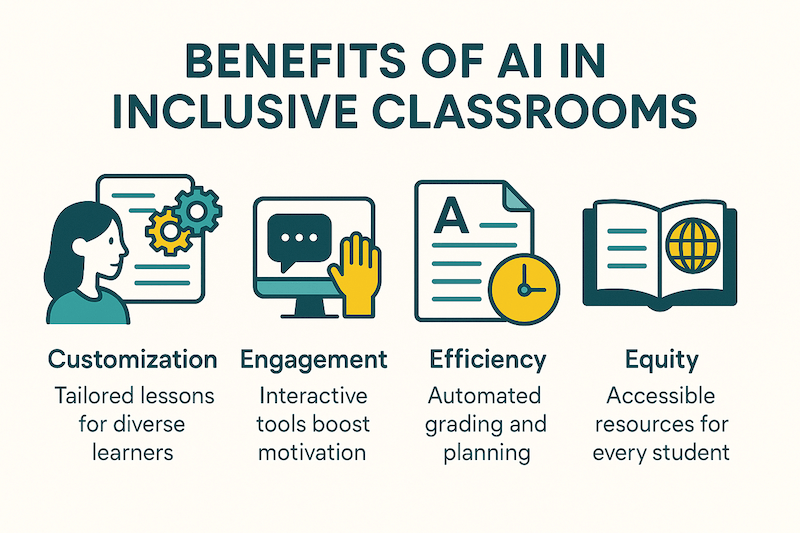
AI personalizes learning by analyzing individual student data to create customized lesson plans, content difficulty levels, and pacing strategies. The technology adapts in real-time based on student responses and progress, ensuring each learner receives appropriate challenges without becoming overwhelmed. This individualized approach prevents students from falling behind while maintaining engagement through tailored educational activities.
In the realm of special education, personalization and accessibility have become buzzwords, promising a future where learning is uniquely tailored to each student's needs. AI technology plays a pivotal role here, reshaping educational landscapes by adapting content and learning speeds based on individual requirements. Picture an AI system that detects when a student is struggling and gently adjusts the pace, or one that challenges a student ready to advance. This technology ensures students don't get lost in the shuffle, unlike more traditional teaching methods, which can potentially leave some trailing behind, resulting in disengagement. With AI tools, educators can craft unique lessons that not only support academic progression but also boost confidence, particularly impactful for those with special needs.
Adaptive technologies are redefining how students engage with learning material, prioritizing individual needs over a one-size-fits-all approach. In practice, AI systems like Read&Write enhance reading and writing skills through supportive features like text-to-speech, providing essential support for learners who may struggle with traditional methods. These AI-powered tools serve as personalized tutors, tailoring their approach to accommodate unique learning requirements. Imagine a student exploring complex subjects through gamification and dynamic pathways using technologies like Curipod. Such activities transform education into an interactive journey, fostering engagement by aligning learning with students' interests and abilities. Not to forget, tools like Canva and SlidesAI.io simplify complex concepts into engaging visuals, catering to diverse styles of learning and aiding special education teachers in making knowledge more accessible.
For students with special needs, making education accessible involves breaking down barriers that traditional environments inadvertently create. AI tools play a crucial role in this transformation, adapting lessons in real time to tailor instruction to individual student requirements. This level of personalization ensures students with diverse challenges, from speech difficulties to learning disabilities, receive the support they need. Advanced communication tools powered by AI adapt interactions for students with unique speech patterns, making exchanges feel natural and effective. Such innovative technology doesn't just design accessible hands-on tasks but enriches them, enhancing academic engagement and fostering confidence. However, leveraging AI's full potential relies heavily on comprehensive teacher training in AI platforms. It's this training that bridges the gap between the potential of AI and its application, ensuring classrooms truly become inclusive environments where all students can thrive.
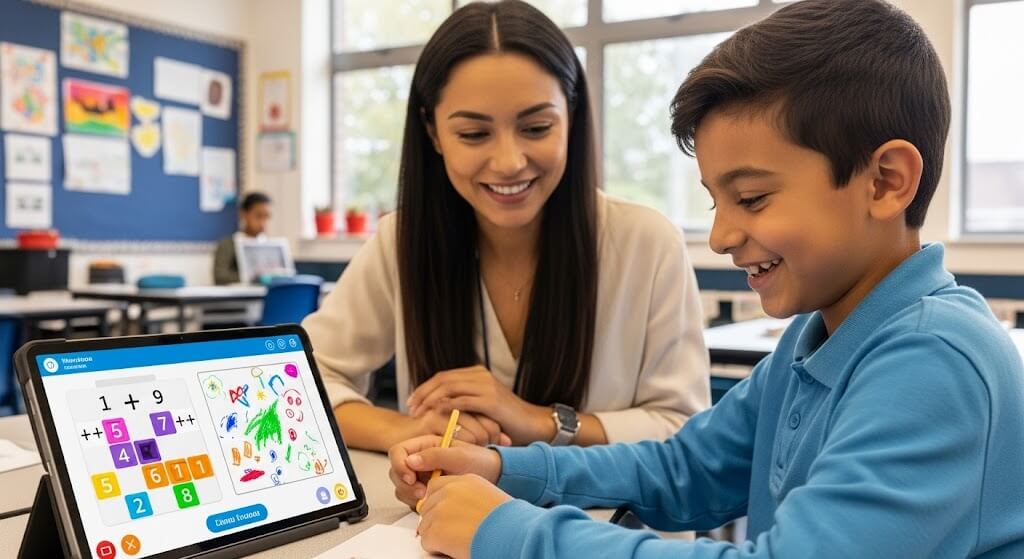
AI-powered communication tools enable non-verbal students to express themselves through alternative methods like symbol-based interfaces and predictive text systems. These technologies support multilingual learners by providing real-time translation and language processing capabilities. Advanced speech recognition and generation tools help students with speech impairments communicate more effectively with teachers and peers.
Traditional assistive technologies have long served a vital role, but now, AI-powered communication tools are taking things several steps further. They don't merely offer basic support; they adapt and evolve with each student. Imagine a tool that learns the unique ways a student expresses themselves, gradually enhancing communication naturalness and effectiveness. Sounds promising, doesn't it? AI-powered speech-to-text technology, for instance, has made considerable strides. No longer is it about just capturing speech; it's about doing so accurately, thereby increasing confidence and participation for students with speech difficulties. By analyzing and tailoring outputs to individual preferences, AI doesn't just assist; it transforms communication into a more accessible and engaging experience.
When it comes to non-verbal students, AI-powered tools open up new avenues of learning and interaction. For those with motor limitations, voice-controlled navigation offers a layer of autonomy, providing them with control over their learning environment. Text-to-speech and speech-to-text capabilities extend beyond mere inclusion; they redefine how non-verbal students engage with their educational journey. These AI tools personalize instruction, seamlessly adapting content and pacing to each student's needs. Imagine the relief and joy of a student who can access interactive content that adapts to their preferences, isn't it something we all would cheer for? Educators, in turn, find they have more time to provide one-on-one support, thanks to AI automating repetitive tasks. These personalized, engaging classroom activities are not just inclusive but empowering, making education more accessible than ever before.
In today's multicultural classrooms, bridging language barriers through AI is becoming essential. AI tools are powerful allies for multilingual learners, especially English Language Learners, as they navigate communication challenges. By adapting to distinctive expression patterns, these modern tools make communication smoother and more effective. Platforms like Read&Write enhance reading and comprehension with text-to-speech features, aiding multilingual students. Meanwhile, Otter.ai's transcription services are an invaluable asset, converting spoken language into text, thus making learning materials more accessible. Such capabilities mean that teachers can craft dynamic, multilingual educational materials, ensuring that no student feels left out due to language differences. By supporting diverse language backgrounds, AI is not just a tool in education but a bridge, bringing together students from varied linguistic backgrounds in a unified, inclusive learning environment.

AI creates dynamic learning environments through interactive simulations, gamified lessons, and multimedia content that adapts to different learning styles. The technology uses student engagement data to adjust activities in real-time, maintaining optimal challenge levels and interest. These personalized, interactive experiences help students with special needs stay motivated and actively participate in their learning journey.
Artificial Intelligence (AI) is crafting a transformation in special education by tailoring activities to the unique requirements of each student. This technology steps in where traditional methods might falter, offering adaptability that's otherwise hard to achieve. With AI-powered systems, content and pacing adjust fluidly in real-time, addressing the diverse and evolving challenges students face. This adaptability doesn't just benefit the students, it also eases the workload for special education teachers. Automating administrative tasks frees up more time for meaningful student-teacher interactions, which, let's be honest, is always a good thing. The beauty of AI in special education is its ability to create more inclusive and effective settings. It provides accommodations that nurture personalized learning paths, ensuring no student is left behind.
Let's face it, maintaining a student's attention can be tricky, especially within traditional learning setups. Interactive educational tools, powered by AI, solve this by bringing in gamification and active participation to boost student engagement. Think of platforms like Pear Deck; they allow students to dive into presentations with real-time questions and activities, actively involving them rather than having them just sit passively. And there's Nearpod, which lets teachers design personalized, multimedia-rich lessons. This isn't just about looking good; it's about real-time assessments and tracking, giving educators an upper hand in understanding student progress. The crux here is customization, these tools adapt educational pathways to match individual student abilities and interests. Plus, tools like Curipod and MindMeister aren't just flashy. They promote innovative teaching methods through gamification and visual concept organization. In short, such tools make classroom involvement lively while deepening comprehension, a win-win for students and teachers alike.
Gamification isn't just for monotonous tasks; in special education, it's a game-changer, pun intended. By weaving AI tools into the learning fabric, educators can create truly engaging classroom activities tailored to each student's needs. These AI-powered environments provide immediate feedback and adjust pacing on the fly, keeping students motivated and engaged. Standardized instruction often fails to capture students' attention or cater to individual learning speeds, but gamification provides a fresh alternative. Imagine the empowerment students feel when practicing skills in a simulated environment, not only is it low-pressure, but it's also highly interactive. For special education teachers, incorporating AI with gamified elements enriches the teaching toolkit. It's about crafting activities that translate to better educational outcomes for students with disabilities. These dynamic methods aren't just a fad; they represent a meaningful shift towards inclusivity and personalized education.
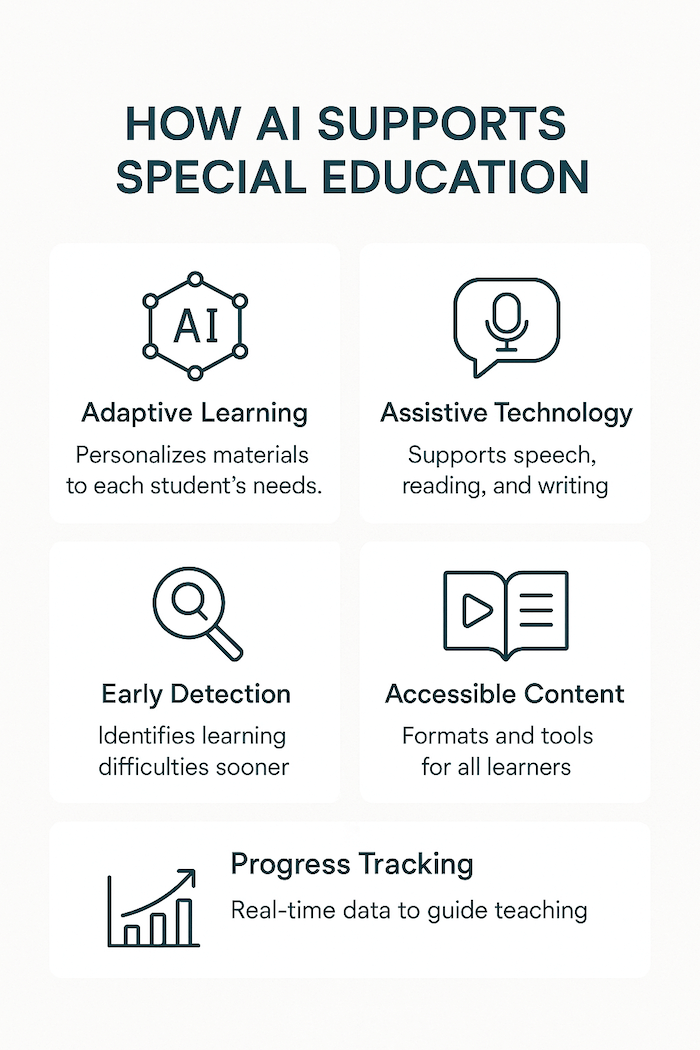
AI empowers special education teachers by automating time-consuming administrative tasks like Individual Education Plan creation and progress tracking. The technology provides valuable data insights about student performance and learning patterns, helping educators make informed instructional decisions. This support frees up teachers to focus more time on direct student interaction and personalized instruction.
Educators are finding that these AI technologies can lift more than just the administrative burdens off their shoulders. By automating repetitive tasks, AI allows teachers to dedicate more time to their core mission: nurturing student growth. This support transforms the classroom into a space where confidence can bloom. By fostering independence and reducing the barriers often associated with traditional learning methods, educators can create a more inclusive learning environment. AI doesn't just change how education happens, it changes the outcome, helping students break through the ceiling of their potential.
With AI-driven data analytics, educators gain a valuable tool that uncovers learning gaps early and suggests targeted interventions. This isn't just about identifying problems; it's about being proactive and informed. It might feel a tad overwhelming at first, there's a lot of data, after all, but this wealth of information empowers teachers to personalize activities like never before.
By freeing educators from the chains of tedious administrative tasks, AI allows for more meaningful interaction with students. Who wouldn't want more time to engage directly with learners? This kind of interaction allows teachers to develop a deeper understanding of how their students are learning, maximizing the educational impact. The precision that AI lends to intervention strategies ensures that educators aren't shooting in the dark; they're making well-informed decisions that cater to the unique needs of each student.
For educators trying to bridge learning gaps, these tools are indispensable. By analyzing real-time data, AI can suggest customized content that resonates with specific learning styles and needs. The classroom experience becomes one where teaching methods morph and adapt to each student's understanding, a dream scenario for any special education teacher.
Engagement skyrockets when you meet students where they are, and AI supports teachers in crafting those personalized encounters. By keeping an eye on how students interact with the material, AI can highlight peak learning moments and suggest content tweaks that keep students hooked. In the realm of Individual Education Plans (IEPs), this means less guesswork and more tailored strategies that make a real difference.
Of course, as with any technology, there's a need to handle it with care, especially when it comes to data privacy and security. Protecting sensitive information related to students' disabilities is paramount. Educators must walk the line between innovation and caution, ensuring that while they're unlocking new educational potentials, they're also safeguarding the integrity and privacy of their students. With this balance, AI not only supports learning but builds a framework for trust and security in education environments.

Special education teachers face challenges including the need for comprehensive training on AI platforms and tools to use them effectively. Many educators struggle with balancing technology integration while maintaining essential human connections with their students. Limited resources, technical support, and concerns about over-reliance on technology also present significant implementation barriers.
AI tools are starting to make a significant impact by reducing workload and simplifying complex tasks. For instance, special education teachers can leverage AI to craft personalized activities, offering tailored feedback and interventions that are more precise. The incorporation of AI-powered tools like interactive presentations and gamified assessments has also shown promise in enhancing student engagement. Yet, as with any technology, there are concerns, particularly about data privacy and the risk of diminishing essential human interactions. Anyone who's been involved in special education knows how irreplaceable genuine connections with students are, so it's a balance that must be approached with thoughtfulness and care.
Teacher shortages add another layer of challenge, especially in special education, where the demand for personalized attention is high. AI can step in as a much-needed partner in this context. By automating administrative tasks, AI reduces the pressure on educators, allowing them to focus more on what they do best, teaching and nurturing their students. For example, when it comes to preparing individual education plans, AI tools can efficiently collect and analyze data, streamlining what was once a time-consuming process. The swift ability of AI-driven analytics to identify learning gaps means educators can now act quickly, offering targeted interventions precisely when needed.
Moreover, AI integration brings an array of communication and task automation tools, which makes navigating the chaos of classroom management a bit smoother. Teachers find that by using AI resources during lesson planning, they save time, ultimately boosting their productivity. Of course, the human touch remains vital. AI should be seen as a supportive assistant rather than a replacement for the direct, interpersonal educator-student interactions that form the core of teaching.

Educators venturing into the world of AI should receive ample support, which is why professional development workshops focusing on AI in special education are vital. These sessions emphasize interactive learning that guides teachers in transforming their practices to foster student success. Through these workshops, educators learn to incorporate AI tools meaningfully, enhancing differentiation and helping tailor activities for students with unique needs.
Strategies from these training programs offer insights into integrating AI within lesson designs. As teachers become familiar with AI, they notice improved student engagement and educational outcomes. Another key aspect of these workshops is the opportunity they afford teachers to explore different AI tools and determine which align best with their teaching styles and responsibilities. It's not a one-size-fits-all; the choice of tools can be as unique as the educators and students themselves.
Comprehensive digital handbooks are often provided to participants, serving as valuable resources long after the workshops conclude. Equipped with these, educators can seamlessly weave AI into their daily routines, ultimately saving time and fostering a more efficient learning environment. As with any tool, it's about understanding how to wield it effectively, and these training programs are a step toward empowering educators to do just that.
The primary risks include privacy concerns related to collecting and storing sensitive student data, particularly for vulnerable special education populations. Over-dependence on AI technology may reduce critical thinking skills and diminish important human interactions between teachers and students. Technical malfunctions, bias in AI algorithms, and unequal access to technology can also create educational disparities.
While AI tools can offer personalized educational activities that adjust to the unique needs of each student, the journey to effective implementation is fraught with potential pitfalls. One could wonder, does the reliance on AI risk diminishing the crucial human elements of teaching? This is an area where balance is key, as over-dependence on technology might inadvertently overshadow the irreplaceable, intuitive aspects of human interactions essential in special education. Besides, these intelligent systems are yet to perfectly emulate the nuanced emotional and social support that students, especially those with disabilities, often need. Equally important are considerations around privacy. Could the detailed data collection required by AI systems lead to concerns about student privacy and data security? That's a question that requires careful, ongoing attention.
There's a valid concern that such heavy reliance on Artificial intelligence might edge out the crucial human elements of teaching, especially the development of critical-thinking skills. After all, technology isn't intended to replace the foundational skills traditional teaching methods support, such as deep analysis and socio-emotional growth. The challenge lies in integrating AI in ways that complement these teaching methods without overshadowing them. Moreover, safeguarding privacy while fostering critical-thinking skills means educators must thoughtfully plan their use of AI tools. In the end, the goal is striking a harmonious balance, where technological prowess meets the nuanced needs of comprehensive education.
AI should enhance rather than replace traditional teaching methods by providing data-driven insights that inform human decision-making. The most effective approach combines AI-powered personalization tools with hands-on, relationship-based instruction from qualified special education teachers. This balanced integration maintains the crucial human element while leveraging technology to improve individualized support and accessibility.
AI tools are beginning to make waves, especially in special education. Perhaps surprisingly, these tools can seamlessly complement traditional teaching methods. Picture this: lessons that are tailor-made, catering to the unique interests and learning needs of each student. This is no longer a dream but a reality facilitated by modern technology. By automating routine tasks, such as lesson planning and grading, AI platforms free up valuable time for educators. This shift enables teachers to focus on building impactful, direct interactions with their students. Indeed, AI-driven tools offer capabilities that can enhance student performance and engagement, providing real-time analytics and personalized activities. So, perhaps AI doesn't replace the traditional approach but, rather, augments it, creating a more inclusive and dynamic teaching environment.
Integrating AI into special education doesn't mean leaving human instruction behind; instead, it's all about harmony. AI can handle the nitty-gritty administrative tasks that might otherwise swamp an educator's day. By doing so, it creates more room for meaningful, one-on-one student interactions. Picture a classroom where AI analyzes and adapts educational content on the fly, making it inclusive and specifically tailored for every student, especially those with unique learning needs. Imagine a world where teachers no longer need to log endless paperwork, thanks to AI-powered efficiency and progress monitoring tools.

Key AI technologies include adaptive learning platforms that adjust content difficulty, speech-to-text and text-to-speech tools for communication support, and predictive analytics for early intervention identification. Other transformative technologies encompass virtual reality for immersive learning experiences, AI tutoring systems, and automated progress monitoring tools. These technologies work together to create more inclusive and effective special education environments.
From supporting literacy to enabling independence, these tools offer personalized, adaptive activities that help students with diverse needs thrive. Below are eight innovative AI technologies making a measurable impact in classrooms today:
1. InnerVoice: 3D Avatar Communication Development
InnerVoice empowers students with autism and communication disorders by turning photos into AI-powered avatars. These avatars model speech, emotions, and social interactions, helping students practice language in a safe, engaging way.
2. Microsoft Immersive Reader: Comprehensive Literacy Support
This free tool supports students with dyslexia, ADHD, and visual processing issues through text-to-speech, syllable breakdowns, and adjustable formatting, making reading more accessible and less overwhelming.
3. DYSOLVE AI: Personalized Dyslexia Intervention
DYSOLVE uses autonomous AI to pinpoint and improve each learner's unique language processing challenges, offering tailored activities proven to build reading fluency over time.
4. DreamBox Learning: Adaptive Mathematics Instruction
DreamBox personalizes math lessons in real time by analyzing every interaction. Students receive instant feedback, while teachers get detailed insights to guide instruction.
5. Seeing AI: Visual Accessibility and Independence
Developed by Microsoft, this app converts printed and visual information into audio descriptions, giving students who are blind or have low vision greater independence in learning.
6. Jamworks: Hearing Accessibility and Note-Taking Support
Jamworks provides live captions, automatic lecture summaries, and interactive flashcards, making it easier for students with hearing impairments or ADHD to keep up in class.
7. CognitiveBotics: Cognitive and Social Development
This platform blends AI-guided therapy games, progress tracking, and real-time adaptation to support communication, social skills, and academic development for students with autism and developmental delays.
8. DreamBox Learning (Math & Reading): Dual-Domain Adaptive Learning
Combining reading and math modules, DreamBox offers a unique dual-discipline platform that adapts lessons to each student's pace, supporting consistent progress across core skills.
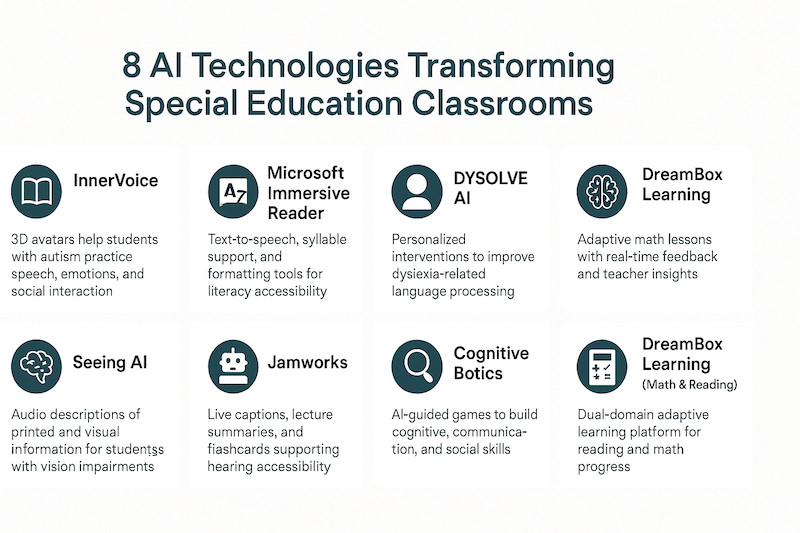
Research studies demonstrate significant improvements in student engagement and learning outcomes when AI tools are properly implemented in special education settings. Key findings show that personalized AI interventions can accelerate skill development and reduce the achievement gap for students with disabilities. However, studies also emphasize the importance of teacher training and maintaining human oversight in AI-assisted instruction.
There is growing interest in academia and research on the use of artificial intelligence to improve learning outcomes for students with special educational needs. Recent studies explore how generative AI, adaptive learning systems, and inclusive technologies can address diverse challenges such as intellectual disabilities, language-processing differences, and social inclusion.
1. Generative AI and Training Employees with Special Needs (Upadhyay, 2024)
This viewpoint discusses how generative AI creates personalized learning for individuals with disabilities. It highlights the design of adaptive learning systems that consider intellectual and developmental disabilities and learning challenges. The study emphasizes collaboration among organizations to ensure inclusive education and equitable opportunities. By tailoring content to learners' abilities, generative AI supports skill development and social inclusion in workplaces.
2. Framework Design for Reinforcing the Potential of XR Technologies in Transforming Inclusive Education (Barbu et al., 2025)
This paper proposes an XR and generative AI framework for adaptive learning systems supporting students with learning challenges and language-processing differences. The platform personalizes content in real time, ensuring accessibility and engagement. Combining immersive XR and generative AI addresses limitations of static materials and fosters inclusive education. The study underscores the importance of social equity and social inclusion for learners with intellectual and developmental disabilities.
3. Artificial Intelligence Promoting the Inclusion of Students with Special Needs in Physical Education Classes (Guedes et al., 2024)
This research shows how AI tools personalize physical education for students with intellectual and developmental disabilities and autistic students. It details AI-based assessment, gesture recognition, adaptive activities, and real-time feedback to enable inclusive education and social inclusion. Ethical concerns and teacher training needs are addressed to ensure responsible AI integration.
4. Leveraging AI to Develop Adaptive Learning Technologies for Disabled Students (Pradeep and Sahana, 2025)
This study evaluates AI-driven adaptive learning systems designed for students with disabilities. Experimental findings reveal AI significantly improves learning outcomes and engagement compared to traditional methods. Emphasis is placed on inclusive education and personalized support, particularly addressing learning challenges and diverse cognitive abilities. The paper also discusses how adaptive technologies can bridge gaps in access and foster social inclusion for marginalized learners.
5. Enhancing Mathematics Education for Students with Special Educational Needs Through Generative AI (Rizos et al., 2024)
This case study in Greece explores generative AI lesson plans for students with special educational needs. Customized worksheets created with ChatGPT improved engagement, confidence, and learning outcomes. The study showcases practical strategies for integrating generative AI into classrooms to support inclusive education and address learning challenges. Recommendations highlight best practices for teachers to foster positive attitudes toward subjects like math among diverse learners.
Envision a classroom where AI meticulously customizes lessons for each student, fostering growth at an individualized pace. The prospect of computers collaborating with educators to enhance the educational landscape is both thrilling and thought-provoking.
AI's role in special education transcends being a mere futuristic notion; it is a burgeoning reality, actively crafting personalized learning pathways and enhancing education accessibility for students with special needs. This technology adeptly accommodates varied learning styles and empowers non-verbal or multilingual students to express themselves. While it equips educators with valuable data and innovative tools, it concurrently raises concerns regarding privacy and the vital equilibrium between technology and critical-thinking skills.

This article will meticulously examine the multifaceted aspects of AI in special education, emphasizing the opportunities it presents and the challenges it may introduce. We will explore how AI can support educators, address challenges such as teacher shortages, and underscore the necessity of aligning AI tools with educational objectives. Let us navigate this evolving era of learning and explore the path where the synergy between humans and technology may lead.
AI in special education offers personalized learning pathways that adapt to each student's unique needs and learning pace. The technology enhances accessibility through tools like text-to-speech and adaptive communication systems, while streamlining administrative tasks for educators. These benefits help ensure students with special needs receive more individualized attention and support.

Exploring the promise of AI in special education feels, well, a bit like we're stepping into the future today. AI tools offer exciting opportunities to enkindle highly engaging, individualized activities for students with special needs.

Benefits of AI in Special Education:
Despite its potential, several concerns persist, namely data privacy, cost implications, and the risk of diminishing essential human interaction in educational settings. While AI has the potential to revolutionize special education, balancing these tools with human touch remains crucial. As teachers and AI join forces, perhaps the challenge is to dance gracefully between technology and human connection, ensuring neither overshadows the other.

AI personalizes learning by analyzing individual student data to create customized lesson plans, content difficulty levels, and pacing strategies. The technology adapts in real-time based on student responses and progress, ensuring each learner receives appropriate challenges without becoming overwhelmed. This individualized approach prevents students from falling behind while maintaining engagement through tailored educational activities.
In the realm of special education, personalization and accessibility have become buzzwords, promising a future where learning is uniquely tailored to each student's needs. AI technology plays a pivotal role here, reshaping educational landscapes by adapting content and learning speeds based on individual requirements. Picture an AI system that detects when a student is struggling and gently adjusts the pace, or one that challenges a student ready to advance. This technology ensures students don't get lost in the shuffle, unlike more traditional teaching methods, which can potentially leave some trailing behind, resulting in disengagement. With AI tools, educators can craft unique lessons that not only support academic progression but also boost confidence, particularly impactful for those with special needs.
Adaptive technologies are redefining how students engage with learning material, prioritizing individual needs over a one-size-fits-all approach. In practice, AI systems like Read&Write enhance reading and writing skills through supportive features like text-to-speech, providing essential support for learners who may struggle with traditional methods. These AI-powered tools serve as personalized tutors, tailoring their approach to accommodate unique learning requirements. Imagine a student exploring complex subjects through gamification and dynamic pathways using technologies like Curipod. Such activities transform education into an interactive journey, fostering engagement by aligning learning with students' interests and abilities. Not to forget, tools like Canva and SlidesAI.io simplify complex concepts into engaging visuals, catering to diverse styles of learning and aiding special education teachers in making knowledge more accessible.
For students with special needs, making education accessible involves breaking down barriers that traditional environments inadvertently create. AI tools play a crucial role in this transformation, adapting lessons in real time to tailor instruction to individual student requirements. This level of personalization ensures students with diverse challenges, from speech difficulties to learning disabilities, receive the support they need. Advanced communication tools powered by AI adapt interactions for students with unique speech patterns, making exchanges feel natural and effective. Such innovative technology doesn't just design accessible hands-on tasks but enriches them, enhancing academic engagement and fostering confidence. However, leveraging AI's full potential relies heavily on comprehensive teacher training in AI platforms. It's this training that bridges the gap between the potential of AI and its application, ensuring classrooms truly become inclusive environments where all students can thrive.

AI-powered communication tools enable non-verbal students to express themselves through alternative methods like symbol-based interfaces and predictive text systems. These technologies support multilingual learners by providing real-time translation and language processing capabilities. Advanced speech recognition and generation tools help students with speech impairments communicate more effectively with teachers and peers.
Traditional assistive technologies have long served a vital role, but now, AI-powered communication tools are taking things several steps further. They don't merely offer basic support; they adapt and evolve with each student. Imagine a tool that learns the unique ways a student expresses themselves, gradually enhancing communication naturalness and effectiveness. Sounds promising, doesn't it? AI-powered speech-to-text technology, for instance, has made considerable strides. No longer is it about just capturing speech; it's about doing so accurately, thereby increasing confidence and participation for students with speech difficulties. By analyzing and tailoring outputs to individual preferences, AI doesn't just assist; it transforms communication into a more accessible and engaging experience.
When it comes to non-verbal students, AI-powered tools open up new avenues of learning and interaction. For those with motor limitations, voice-controlled navigation offers a layer of autonomy, providing them with control over their learning environment. Text-to-speech and speech-to-text capabilities extend beyond mere inclusion; they redefine how non-verbal students engage with their educational journey. These AI tools personalize instruction, seamlessly adapting content and pacing to each student's needs. Imagine the relief and joy of a student who can access interactive content that adapts to their preferences, isn't it something we all would cheer for? Educators, in turn, find they have more time to provide one-on-one support, thanks to AI automating repetitive tasks. These personalized, engaging classroom activities are not just inclusive but empowering, making education more accessible than ever before.
In today's multicultural classrooms, bridging language barriers through AI is becoming essential. AI tools are powerful allies for multilingual learners, especially English Language Learners, as they navigate communication challenges. By adapting to distinctive expression patterns, these modern tools make communication smoother and more effective. Platforms like Read&Write enhance reading and comprehension with text-to-speech features, aiding multilingual students. Meanwhile, Otter.ai's transcription services are an invaluable asset, converting spoken language into text, thus making learning materials more accessible. Such capabilities mean that teachers can craft dynamic, multilingual educational materials, ensuring that no student feels left out due to language differences. By supporting diverse language backgrounds, AI is not just a tool in education but a bridge, bringing together students from varied linguistic backgrounds in a unified, inclusive learning environment.

AI creates dynamic learning environments through interactive simulations, gamified lessons, and multimedia content that adapts to different learning styles. The technology uses student engagement data to adjust activities in real-time, maintaining optimal challenge levels and interest. These personalized, interactive experiences help students with special needs stay motivated and actively participate in their learning journey.
Artificial Intelligence (AI) is crafting a transformation in special education by tailoring activities to the unique requirements of each student. This technology steps in where traditional methods might falter, offering adaptability that's otherwise hard to achieve. With AI-powered systems, content and pacing adjust fluidly in real-time, addressing the diverse and evolving challenges students face. This adaptability doesn't just benefit the students, it also eases the workload for special education teachers. Automating administrative tasks frees up more time for meaningful student-teacher interactions, which, let's be honest, is always a good thing. The beauty of AI in special education is its ability to create more inclusive and effective settings. It provides accommodations that nurture personalized learning paths, ensuring no student is left behind.
Let's face it, maintaining a student's attention can be tricky, especially within traditional learning setups. Interactive educational tools, powered by AI, solve this by bringing in gamification and active participation to boost student engagement. Think of platforms like Pear Deck; they allow students to dive into presentations with real-time questions and activities, actively involving them rather than having them just sit passively. And there's Nearpod, which lets teachers design personalized, multimedia-rich lessons. This isn't just about looking good; it's about real-time assessments and tracking, giving educators an upper hand in understanding student progress. The crux here is customization, these tools adapt educational pathways to match individual student abilities and interests. Plus, tools like Curipod and MindMeister aren't just flashy. They promote innovative teaching methods through gamification and visual concept organization. In short, such tools make classroom involvement lively while deepening comprehension, a win-win for students and teachers alike.
Gamification isn't just for monotonous tasks; in special education, it's a game-changer, pun intended. By weaving AI tools into the learning fabric, educators can create truly engaging classroom activities tailored to each student's needs. These AI-powered environments provide immediate feedback and adjust pacing on the fly, keeping students motivated and engaged. Standardized instruction often fails to capture students' attention or cater to individual learning speeds, but gamification provides a fresh alternative. Imagine the empowerment students feel when practicing skills in a simulated environment, not only is it low-pressure, but it's also highly interactive. For special education teachers, incorporating AI with gamified elements enriches the teaching toolkit. It's about crafting activities that translate to better educational outcomes for students with disabilities. These dynamic methods aren't just a fad; they represent a meaningful shift towards inclusivity and personalized education.

AI empowers special education teachers by automating time-consuming administrative tasks like Individual Education Plan creation and progress tracking. The technology provides valuable data insights about student performance and learning patterns, helping educators make informed instructional decisions. This support frees up teachers to focus more time on direct student interaction and personalized instruction.
Educators are finding that these AI technologies can lift more than just the administrative burdens off their shoulders. By automating repetitive tasks, AI allows teachers to dedicate more time to their core mission: nurturing student growth. This support transforms the classroom into a space where confidence can bloom. By fostering independence and reducing the barriers often associated with traditional learning methods, educators can create a more inclusive learning environment. AI doesn't just change how education happens, it changes the outcome, helping students break through the ceiling of their potential.
With AI-driven data analytics, educators gain a valuable tool that uncovers learning gaps early and suggests targeted interventions. This isn't just about identifying problems; it's about being proactive and informed. It might feel a tad overwhelming at first, there's a lot of data, after all, but this wealth of information empowers teachers to personalize activities like never before.
By freeing educators from the chains of tedious administrative tasks, AI allows for more meaningful interaction with students. Who wouldn't want more time to engage directly with learners? This kind of interaction allows teachers to develop a deeper understanding of how their students are learning, maximizing the educational impact. The precision that AI lends to intervention strategies ensures that educators aren't shooting in the dark; they're making well-informed decisions that cater to the unique needs of each student.
For educators trying to bridge learning gaps, these tools are indispensable. By analyzing real-time data, AI can suggest customized content that resonates with specific learning styles and needs. The classroom experience becomes one where teaching methods morph and adapt to each student's understanding, a dream scenario for any special education teacher.
Engagement skyrockets when you meet students where they are, and AI supports teachers in crafting those personalized encounters. By keeping an eye on how students interact with the material, AI can highlight peak learning moments and suggest content tweaks that keep students hooked. In the realm of Individual Education Plans (IEPs), this means less guesswork and more tailored strategies that make a real difference.
Of course, as with any technology, there's a need to handle it with care, especially when it comes to data privacy and security. Protecting sensitive information related to students' disabilities is paramount. Educators must walk the line between innovation and caution, ensuring that while they're unlocking new educational potentials, they're also safeguarding the integrity and privacy of their students. With this balance, AI not only supports learning but builds a framework for trust and security in education environments.

Special education teachers face challenges including the need for comprehensive training on AI platforms and tools to use them effectively. Many educators struggle with balancing technology integration while maintaining essential human connections with their students. Limited resources, technical support, and concerns about over-reliance on technology also present significant implementation barriers.
AI tools are starting to make a significant impact by reducing workload and simplifying complex tasks. For instance, special education teachers can leverage AI to craft personalized activities, offering tailored feedback and interventions that are more precise. The incorporation of AI-powered tools like interactive presentations and gamified assessments has also shown promise in enhancing student engagement. Yet, as with any technology, there are concerns, particularly about data privacy and the risk of diminishing essential human interactions. Anyone who's been involved in special education knows how irreplaceable genuine connections with students are, so it's a balance that must be approached with thoughtfulness and care.
Teacher shortages add another layer of challenge, especially in special education, where the demand for personalized attention is high. AI can step in as a much-needed partner in this context. By automating administrative tasks, AI reduces the pressure on educators, allowing them to focus more on what they do best, teaching and nurturing their students. For example, when it comes to preparing individual education plans, AI tools can efficiently collect and analyze data, streamlining what was once a time-consuming process. The swift ability of AI-driven analytics to identify learning gaps means educators can now act quickly, offering targeted interventions precisely when needed.
Moreover, AI integration brings an array of communication and task automation tools, which makes navigating the chaos of classroom management a bit smoother. Teachers find that by using AI resources during lesson planning, they save time, ultimately boosting their productivity. Of course, the human touch remains vital. AI should be seen as a supportive assistant rather than a replacement for the direct, interpersonal educator-student interactions that form the core of teaching.

Educators venturing into the world of AI should receive ample support, which is why professional development workshops focusing on AI in special education are vital. These sessions emphasize interactive learning that guides teachers in transforming their practices to foster student success. Through these workshops, educators learn to incorporate AI tools meaningfully, enhancing differentiation and helping tailor activities for students with unique needs.
Strategies from these training programs offer insights into integrating AI within lesson designs. As teachers become familiar with AI, they notice improved student engagement and educational outcomes. Another key aspect of these workshops is the opportunity they afford teachers to explore different AI tools and determine which align best with their teaching styles and responsibilities. It's not a one-size-fits-all; the choice of tools can be as unique as the educators and students themselves.
Comprehensive digital handbooks are often provided to participants, serving as valuable resources long after the workshops conclude. Equipped with these, educators can seamlessly weave AI into their daily routines, ultimately saving time and fostering a more efficient learning environment. As with any tool, it's about understanding how to wield it effectively, and these training programs are a step toward empowering educators to do just that.
The primary risks include privacy concerns related to collecting and storing sensitive student data, particularly for vulnerable special education populations. Over-dependence on AI technology may reduce critical thinking skills and diminish important human interactions between teachers and students. Technical malfunctions, bias in AI algorithms, and unequal access to technology can also create educational disparities.
While AI tools can offer personalized educational activities that adjust to the unique needs of each student, the journey to effective implementation is fraught with potential pitfalls. One could wonder, does the reliance on AI risk diminishing the crucial human elements of teaching? This is an area where balance is key, as over-dependence on technology might inadvertently overshadow the irreplaceable, intuitive aspects of human interactions essential in special education. Besides, these intelligent systems are yet to perfectly emulate the nuanced emotional and social support that students, especially those with disabilities, often need. Equally important are considerations around privacy. Could the detailed data collection required by AI systems lead to concerns about student privacy and data security? That's a question that requires careful, ongoing attention.
There's a valid concern that such heavy reliance on Artificial intelligence might edge out the crucial human elements of teaching, especially the development of critical-thinking skills. After all, technology isn't intended to replace the foundational skills traditional teaching methods support, such as deep analysis and socio-emotional growth. The challenge lies in integrating AI in ways that complement these teaching methods without overshadowing them. Moreover, safeguarding privacy while fostering critical-thinking skills means educators must thoughtfully plan their use of AI tools. In the end, the goal is striking a harmonious balance, where technological prowess meets the nuanced needs of comprehensive education.
AI should enhance rather than replace traditional teaching methods by providing data-driven insights that inform human decision-making. The most effective approach combines AI-powered personalization tools with hands-on, relationship-based instruction from qualified special education teachers. This balanced integration maintains the crucial human element while leveraging technology to improve individualized support and accessibility.
AI tools are beginning to make waves, especially in special education. Perhaps surprisingly, these tools can seamlessly complement traditional teaching methods. Picture this: lessons that are tailor-made, catering to the unique interests and learning needs of each student. This is no longer a dream but a reality facilitated by modern technology. By automating routine tasks, such as lesson planning and grading, AI platforms free up valuable time for educators. This shift enables teachers to focus on building impactful, direct interactions with their students. Indeed, AI-driven tools offer capabilities that can enhance student performance and engagement, providing real-time analytics and personalized activities. So, perhaps AI doesn't replace the traditional approach but, rather, augments it, creating a more inclusive and dynamic teaching environment.
Integrating AI into special education doesn't mean leaving human instruction behind; instead, it's all about harmony. AI can handle the nitty-gritty administrative tasks that might otherwise swamp an educator's day. By doing so, it creates more room for meaningful, one-on-one student interactions. Picture a classroom where AI analyzes and adapts educational content on the fly, making it inclusive and specifically tailored for every student, especially those with unique learning needs. Imagine a world where teachers no longer need to log endless paperwork, thanks to AI-powered efficiency and progress monitoring tools.

Key AI technologies include adaptive learning platforms that adjust content difficulty, speech-to-text and text-to-speech tools for communication support, and predictive analytics for early intervention identification. Other transformative technologies encompass virtual reality for immersive learning experiences, AI tutoring systems, and automated progress monitoring tools. These technologies work together to create more inclusive and effective special education environments.
From supporting literacy to enabling independence, these tools offer personalized, adaptive activities that help students with diverse needs thrive. Below are eight innovative AI technologies making a measurable impact in classrooms today:
1. InnerVoice: 3D Avatar Communication Development
InnerVoice empowers students with autism and communication disorders by turning photos into AI-powered avatars. These avatars model speech, emotions, and social interactions, helping students practice language in a safe, engaging way.
2. Microsoft Immersive Reader: Comprehensive Literacy Support
This free tool supports students with dyslexia, ADHD, and visual processing issues through text-to-speech, syllable breakdowns, and adjustable formatting, making reading more accessible and less overwhelming.
3. DYSOLVE AI: Personalized Dyslexia Intervention
DYSOLVE uses autonomous AI to pinpoint and improve each learner's unique language processing challenges, offering tailored activities proven to build reading fluency over time.
4. DreamBox Learning: Adaptive Mathematics Instruction
DreamBox personalizes math lessons in real time by analyzing every interaction. Students receive instant feedback, while teachers get detailed insights to guide instruction.
5. Seeing AI: Visual Accessibility and Independence
Developed by Microsoft, this app converts printed and visual information into audio descriptions, giving students who are blind or have low vision greater independence in learning.
6. Jamworks: Hearing Accessibility and Note-Taking Support
Jamworks provides live captions, automatic lecture summaries, and interactive flashcards, making it easier for students with hearing impairments or ADHD to keep up in class.
7. CognitiveBotics: Cognitive and Social Development
This platform blends AI-guided therapy games, progress tracking, and real-time adaptation to support communication, social skills, and academic development for students with autism and developmental delays.
8. DreamBox Learning (Math & Reading): Dual-Domain Adaptive Learning
Combining reading and math modules, DreamBox offers a unique dual-discipline platform that adapts lessons to each student's pace, supporting consistent progress across core skills.

Research studies demonstrate significant improvements in student engagement and learning outcomes when AI tools are properly implemented in special education settings. Key findings show that personalized AI interventions can accelerate skill development and reduce the achievement gap for students with disabilities. However, studies also emphasize the importance of teacher training and maintaining human oversight in AI-assisted instruction.
There is growing interest in academia and research on the use of artificial intelligence to improve learning outcomes for students with special educational needs. Recent studies explore how generative AI, adaptive learning systems, and inclusive technologies can address diverse challenges such as intellectual disabilities, language-processing differences, and social inclusion.
1. Generative AI and Training Employees with Special Needs (Upadhyay, 2024)
This viewpoint discusses how generative AI creates personalized learning for individuals with disabilities. It highlights the design of adaptive learning systems that consider intellectual and developmental disabilities and learning challenges. The study emphasizes collaboration among organizations to ensure inclusive education and equitable opportunities. By tailoring content to learners' abilities, generative AI supports skill development and social inclusion in workplaces.
2. Framework Design for Reinforcing the Potential of XR Technologies in Transforming Inclusive Education (Barbu et al., 2025)
This paper proposes an XR and generative AI framework for adaptive learning systems supporting students with learning challenges and language-processing differences. The platform personalizes content in real time, ensuring accessibility and engagement. Combining immersive XR and generative AI addresses limitations of static materials and fosters inclusive education. The study underscores the importance of social equity and social inclusion for learners with intellectual and developmental disabilities.
3. Artificial Intelligence Promoting the Inclusion of Students with Special Needs in Physical Education Classes (Guedes et al., 2024)
This research shows how AI tools personalize physical education for students with intellectual and developmental disabilities and autistic students. It details AI-based assessment, gesture recognition, adaptive activities, and real-time feedback to enable inclusive education and social inclusion. Ethical concerns and teacher training needs are addressed to ensure responsible AI integration.
4. Leveraging AI to Develop Adaptive Learning Technologies for Disabled Students (Pradeep and Sahana, 2025)
This study evaluates AI-driven adaptive learning systems designed for students with disabilities. Experimental findings reveal AI significantly improves learning outcomes and engagement compared to traditional methods. Emphasis is placed on inclusive education and personalized support, particularly addressing learning challenges and diverse cognitive abilities. The paper also discusses how adaptive technologies can bridge gaps in access and foster social inclusion for marginalized learners.
5. Enhancing Mathematics Education for Students with Special Educational Needs Through Generative AI (Rizos et al., 2024)
This case study in Greece explores generative AI lesson plans for students with special educational needs. Customized worksheets created with ChatGPT improved engagement, confidence, and learning outcomes. The study showcases practical strategies for integrating generative AI into classrooms to support inclusive education and address learning challenges. Recommendations highlight best practices for teachers to foster positive attitudes toward subjects like math among diverse learners.